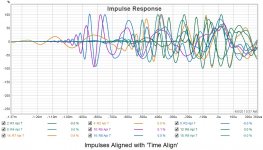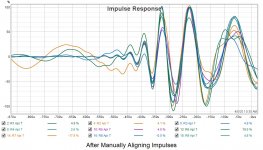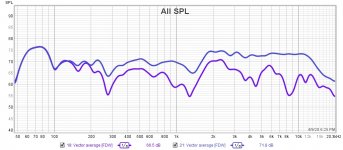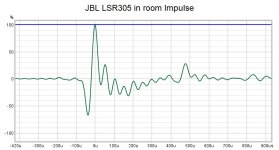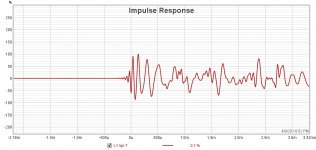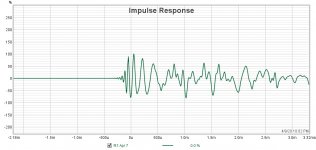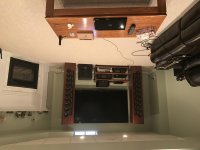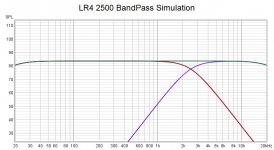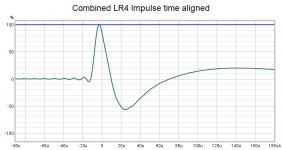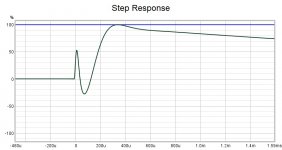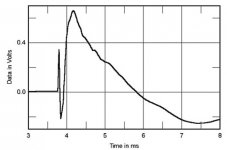As I delve deeper into RePhase Additional Tutorial: 9-point measurements it appears the time align function may not work that well. It suggests that there may be some benefits to manually aligning the impulse responses.
Regards,
Dan
Regards,
Dan
The REW time align function does not do a bad job but it is not perfect either and it somewhat depends on the impulse you are measuring. It is always possible to go back in and align all the impulses manually if you need to to. You also have to look at it in terms of the overall response, the sort of timing errors created by it not being perfect show up as a slight difference in the 10K plus frequency region. Decide for yourself if it is worth the time to align them all perfectly.
One thing to get right is when making a centre sweet spot measurement to make sure that it is at the exact centre of the two speakers. Make a measurement with both speakers playing and look at the impulse. When they are aligned the peaks will join as one. If not move the mic left or right and measure again until they line up on top of each other. This is important to know because it is the best place to listen from, moving your seat to here might well improve stereo imaging more than anything else.
What is your goal with this type of measuring and processing? Averaged measurements can be used for trying to even out the response of an area so there is less variation among seats or as a way of avoiding over correction or trying to reduce the amount of room influence on a measurement.
If you are looking to makes corrections for one listener only the measurements and processing will be quite different than if you are trying to get a better response for more listeners.
There are some things in that link that seem odd to me, if an impulse is different try and find out why, throwing it away will not help to understand what is going on in the room. It is no surprise that the single position measurement looks like the average if the average was based off measurements that looked the same 😉
The last set of averages I took ended up being 3 each side plus a centre, all in a line at ear level across the area of a couch. Result was very similar to using more measurements. According to gedlee 19 measurements is the point of diminishing returns for spatial averaging.
Given that you look to have some subwoofers as well as main speakers capable of playing fairly low, have a look at the multisub optimiser software by andync, quite similar to Harman's soundfield management but free.
One thing to get right is when making a centre sweet spot measurement to make sure that it is at the exact centre of the two speakers. Make a measurement with both speakers playing and look at the impulse. When they are aligned the peaks will join as one. If not move the mic left or right and measure again until they line up on top of each other. This is important to know because it is the best place to listen from, moving your seat to here might well improve stereo imaging more than anything else.
What is your goal with this type of measuring and processing? Averaged measurements can be used for trying to even out the response of an area so there is less variation among seats or as a way of avoiding over correction or trying to reduce the amount of room influence on a measurement.
If you are looking to makes corrections for one listener only the measurements and processing will be quite different than if you are trying to get a better response for more listeners.
There are some things in that link that seem odd to me, if an impulse is different try and find out why, throwing it away will not help to understand what is going on in the room. It is no surprise that the single position measurement looks like the average if the average was based off measurements that looked the same 😉
The last set of averages I took ended up being 3 each side plus a centre, all in a line at ear level across the area of a couch. Result was very similar to using more measurements. According to gedlee 19 measurements is the point of diminishing returns for spatial averaging.
Given that you look to have some subwoofers as well as main speakers capable of playing fairly low, have a look at the multisub optimiser software by andync, quite similar to Harman's soundfield management but free.
Briefly, my goal is to use one or more of these tutorials to learn how to correct the amplitude and phase of my line arrays. These corrections will be applied via a minidsp 2x4HD. So far, all I've accomplished is going from zero knowledge of REW and Rephase to a reasonable amount of comfort using them. This hasn't been without a few bumps along the way but thanks to the kindness of my fellow forum members I feel I'm progressing nicely and sooner or later I'll achieve the results I'm looking for. From my point of view, the experience has both very challenging but enjoyable. I'm not the type to give up easily so expect to see more posts here as I get closer to the end!
Many thanks!
Dan
Many thanks!
Dan
Last edited:
Thanks to SwissBear’s tutorials I’ve learned how to apply or remove windowing to any measurement in REW at will. Why this is interesting is that SB says to accurately export phase to Rephase. Windowing has to be turned on, and to accurately export amplitude it has to be turned off.
😀
Regards,
Dan
😀
Regards,
Dan
If the EQ was all done in REW then there is actually no need to import the amplitude measurement into rephase other than to confirm that the EQ is working as desired.
The point of using a FDW on the phase is to clean it up and avoid trying to micro manage it in rephase.
The point of using a FDW on the phase is to clean it up and avoid trying to micro manage it in rephase.
No problem, if this is your first measurement attempt you picked a steep curve to learn on 🙂
The vector average needs to be performed first before any other form of smoothing or windowing. The timing reference should have aligned everything. Check the impulses of the individual measurements in the overlay screen to see if they are aligned correctly, if not move them or use the time align function before vector averaging.
This ended up being excellent advice because the additional tutorial suggested manually aligning impulses.
Regards,
Dan
Here's the two tutorials I'm referring to.
REW measurement averaging + rePhase
and
Rephase Additional Tutorial
Regards,
Dan
REW measurement averaging + rePhase
and
Rephase Additional Tutorial
Regards,
Dan
Here's an example of my impulses for the nine measurements of one channel.
The first image is the impulses aligned using REW's 'time align' function. The second image is the result of manually aligning them all.
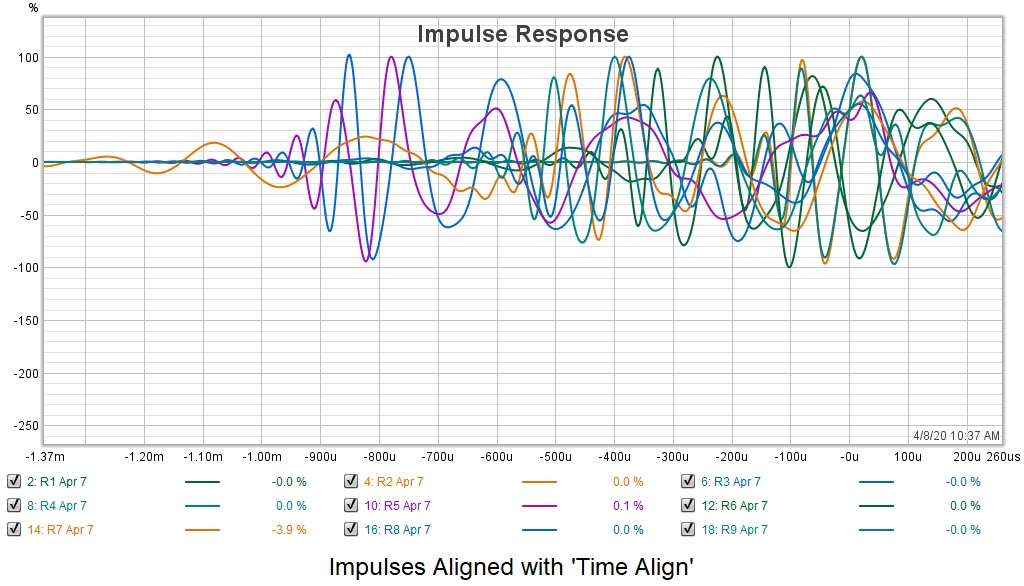
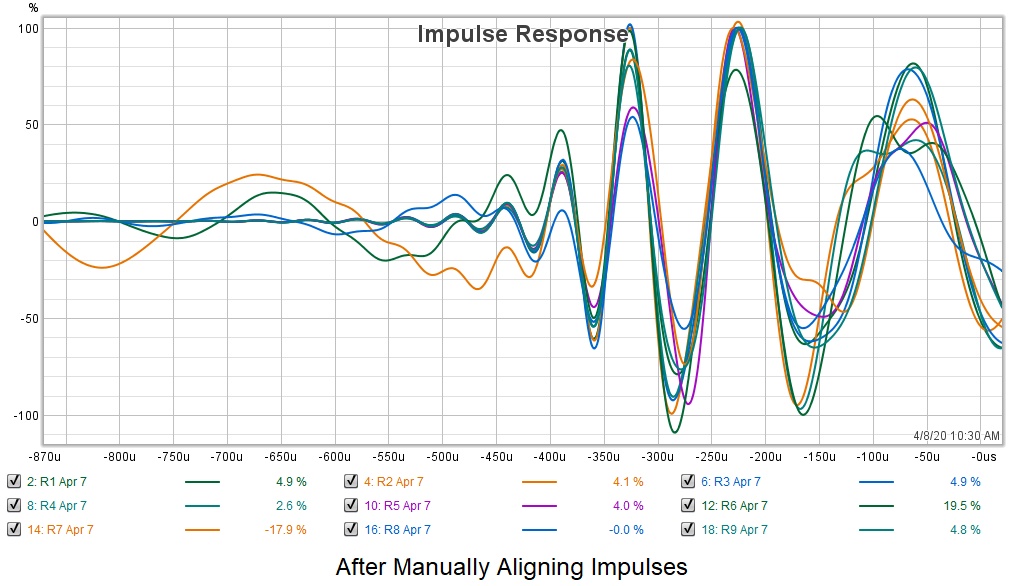
Regards,
Dan
The first image is the impulses aligned using REW's 'time align' function. The second image is the result of manually aligning them all.
Regards,
Dan
Attachments
Your impulse responses do not look right, it is no surprise that REW is not having much luck. What speakers and crossovers have you got running here?
This is the impulse response of a JBL LSR305 in my room, you can see that the tweeter and woofer are out of phase but it is otherwise clean with a bit of ripple, you have a lot going on before the peaks and you have a lot of peaks.
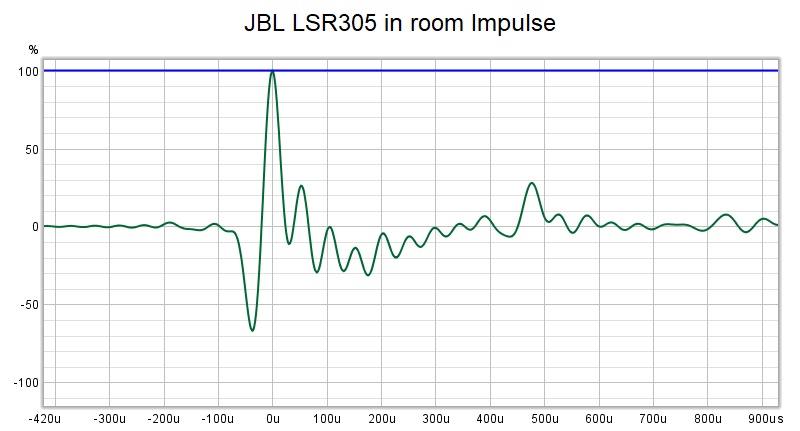
If you can just try the main speakers by themselves.
This is the impulse response of a JBL LSR305 in my room, you can see that the tweeter and woofer are out of phase but it is otherwise clean with a bit of ripple, you have a lot going on before the peaks and you have a lot of peaks.
If you can just try the main speakers by themselves.
Attachments
First is the impulse of my left speaker at an equidistant listening position from the right speaker. The second image is the right speaker's impulse.
Regards,
Dan
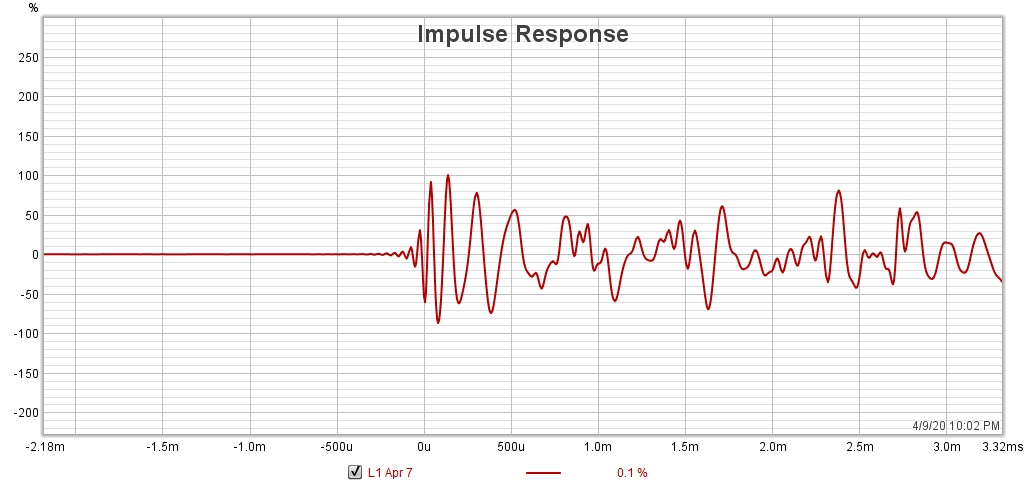
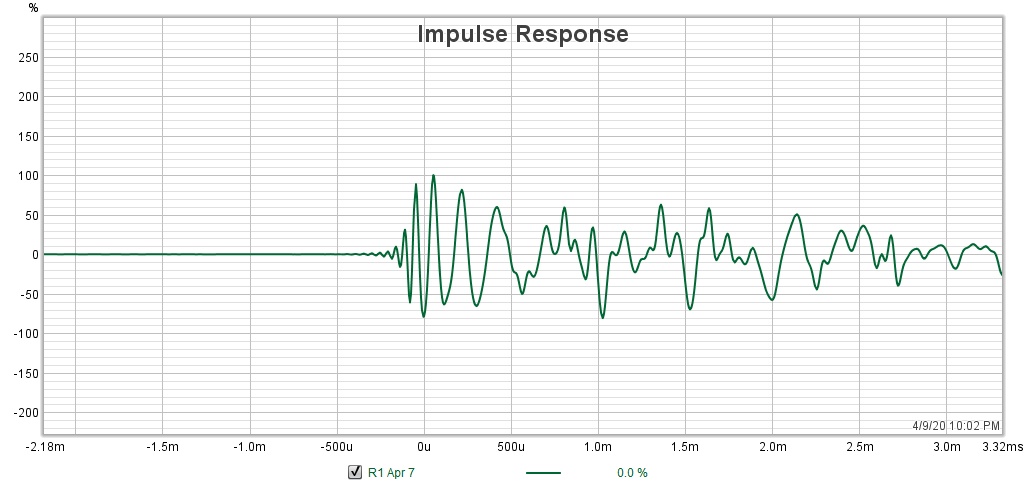
They are line arrays with Foundtek ribbon tweeters.
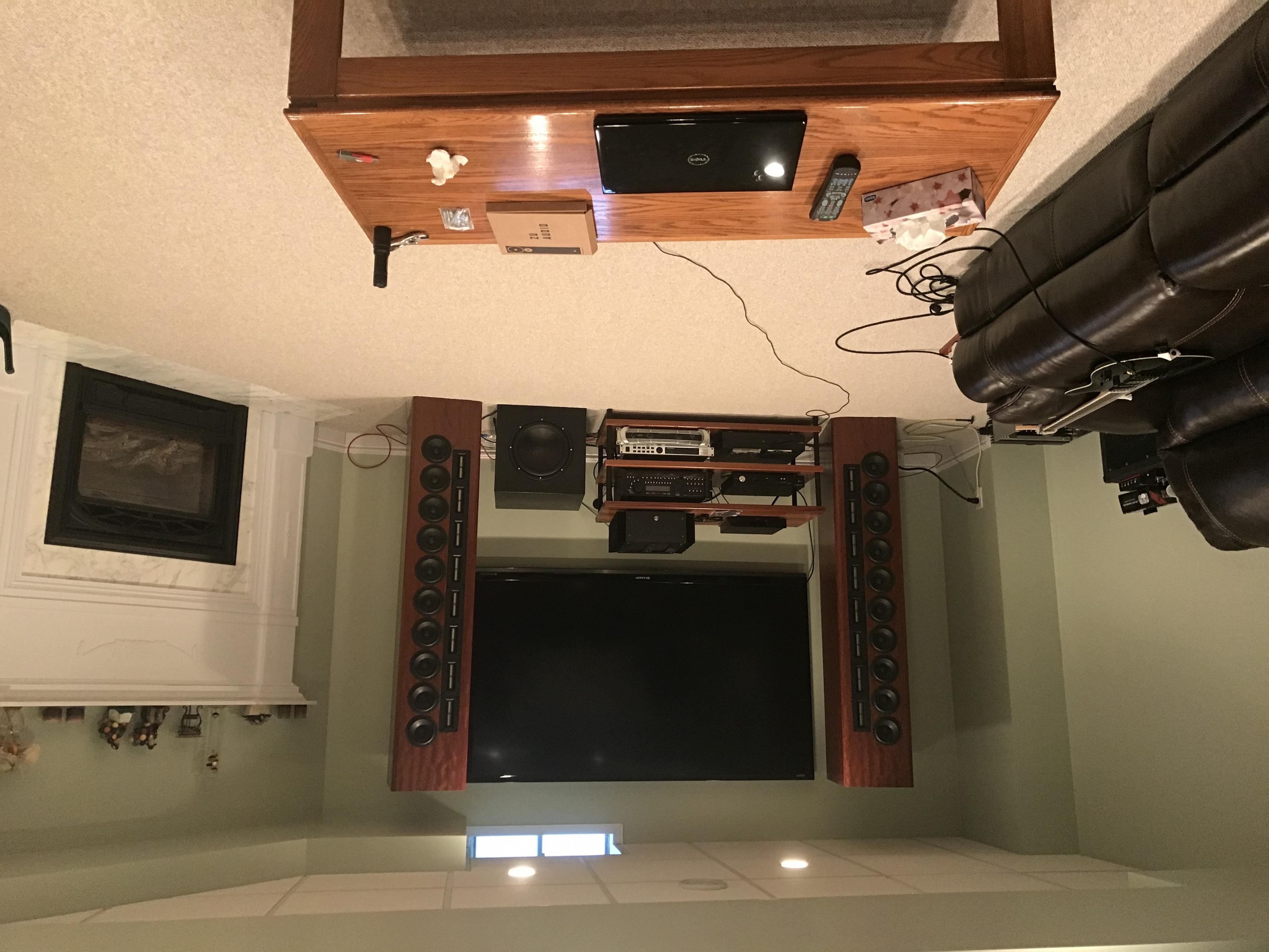
Regards,
Dan
Regards,
Dan
They are line arrays with Foundtek ribbon tweeters.
Regards,
Dan
Attachments
Last edited:
Your impulse responses do not look right, it is no surprise that REW is not having much luck. What speakers and crossovers have you got running here?
This is the impulse response of a JBL LSR305 in my room, you can see that the tweeter and woofer are out of phase but it is otherwise clean with a bit of ripple, you have a lot going on before the peaks and you have a lot of peaks.

If you can just try the main speakers by themselves.
A line array consisting of
Silver Flute W14RC25-08 ohm 5-1/2" Wool Cone
and
Fountek NeoCd2.0M-blk 5" Ribbon Tweeter - Rectangular Flange - Black
Both on fourth order LR crossing over around 2500hz.
Regards,
Dan
Can you run a full range sweep on your subwoofer to make sure your measurement setup is good? Pull it out from the wall and measure about a metre away from it while running a full range sweep, turn off any crossover to it.
Or any other small or fullrange speaker you might have.
Is your crossover wired in phase being LR4?
Trying to work out why the impulse goes negative first.
Or any other small or fullrange speaker you might have.
Is your crossover wired in phase being LR4?
Trying to work out why the impulse goes negative first.
To add a little bit more rephase into the discussion I made a simulation of a speaker with 20Hz 20K 2nd order rolloff and 2.5K LR4 IIR crossover from rephase impulses and combined them in REW after being time aligned.
So this is an idealised response
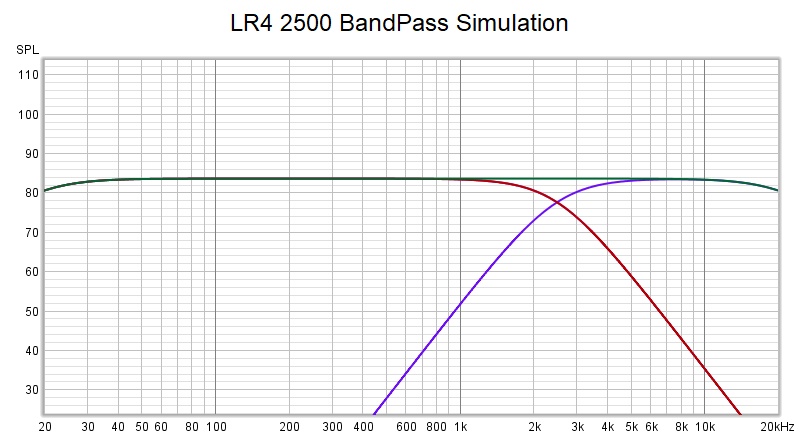
Impulse
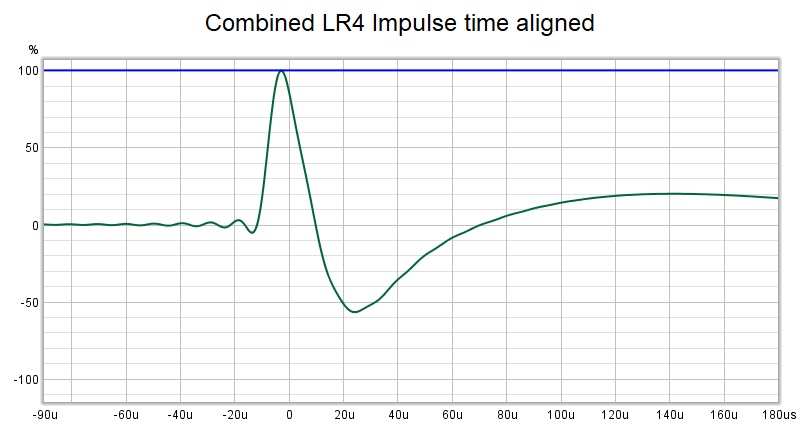
Step
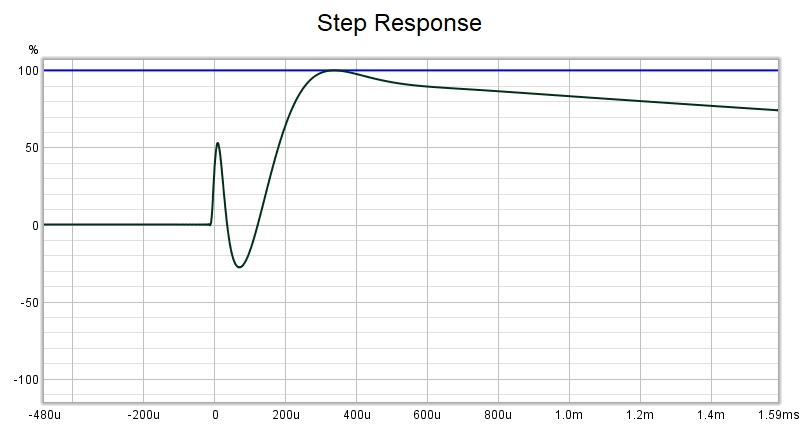
For comparison a Revel M106 step measured in Stereophile, with a similar LR4 crossover.
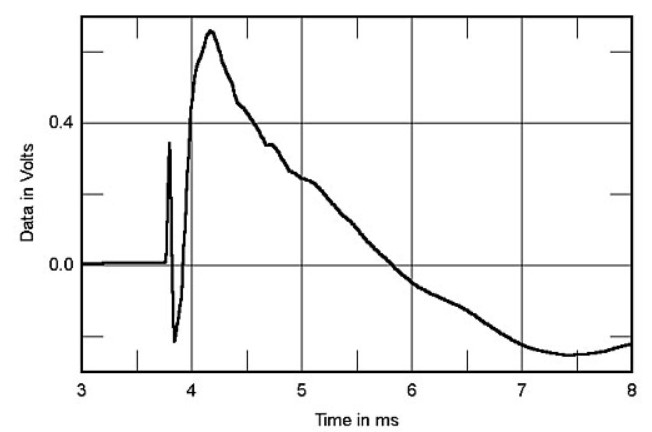
So this is an idealised response
Impulse
Step
For comparison a Revel M106 step measured in Stereophile, with a similar LR4 crossover.
Attachments
Can you run a full range sweep on your subwoofer to make sure your measurement setup is good? Pull it out from the wall and measure about a metre away from it while running a full range sweep, turn off any crossover to it.
Or any other small or fullrange speaker you might have.
Is your crossover wired in phase being LR4?
Trying to work out why the impulse goes negative first.
Sorry, sub is excluded from all measurements.
I do have another pair of new full range speakers I will measure. More later....
Regards,
Dan
First is the impulse of my left speaker at an equidistant listening position from the right speaker. The second image is the right speaker's impulse.
Regards,
Dan
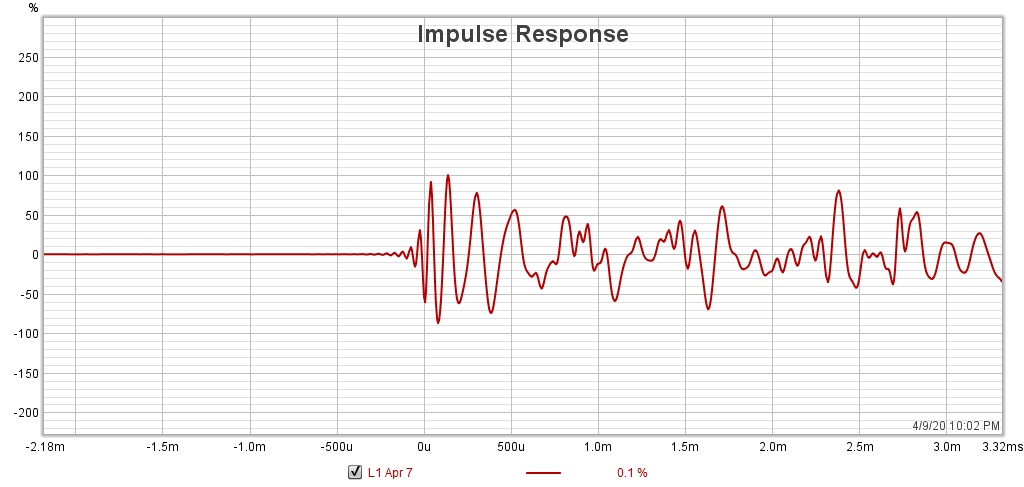
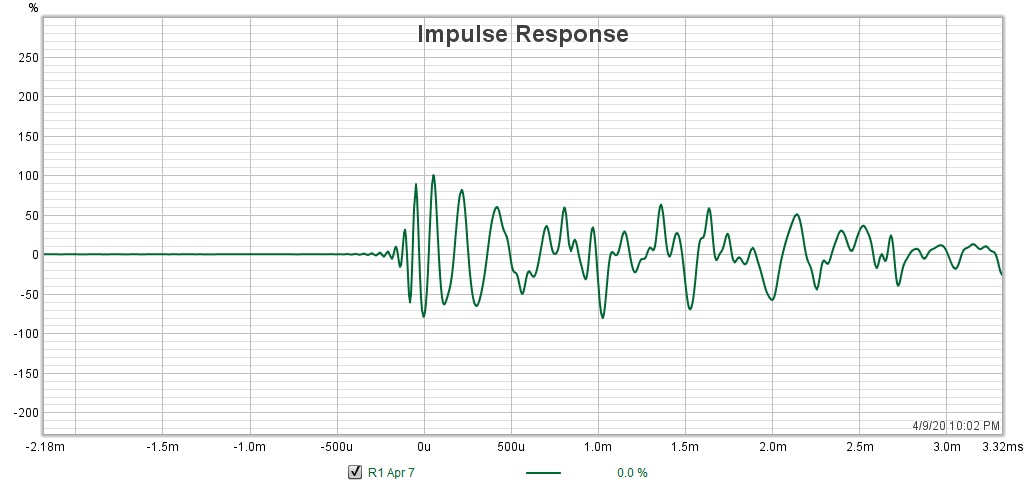
They are line arrays with Foundtek ribbon tweeters.
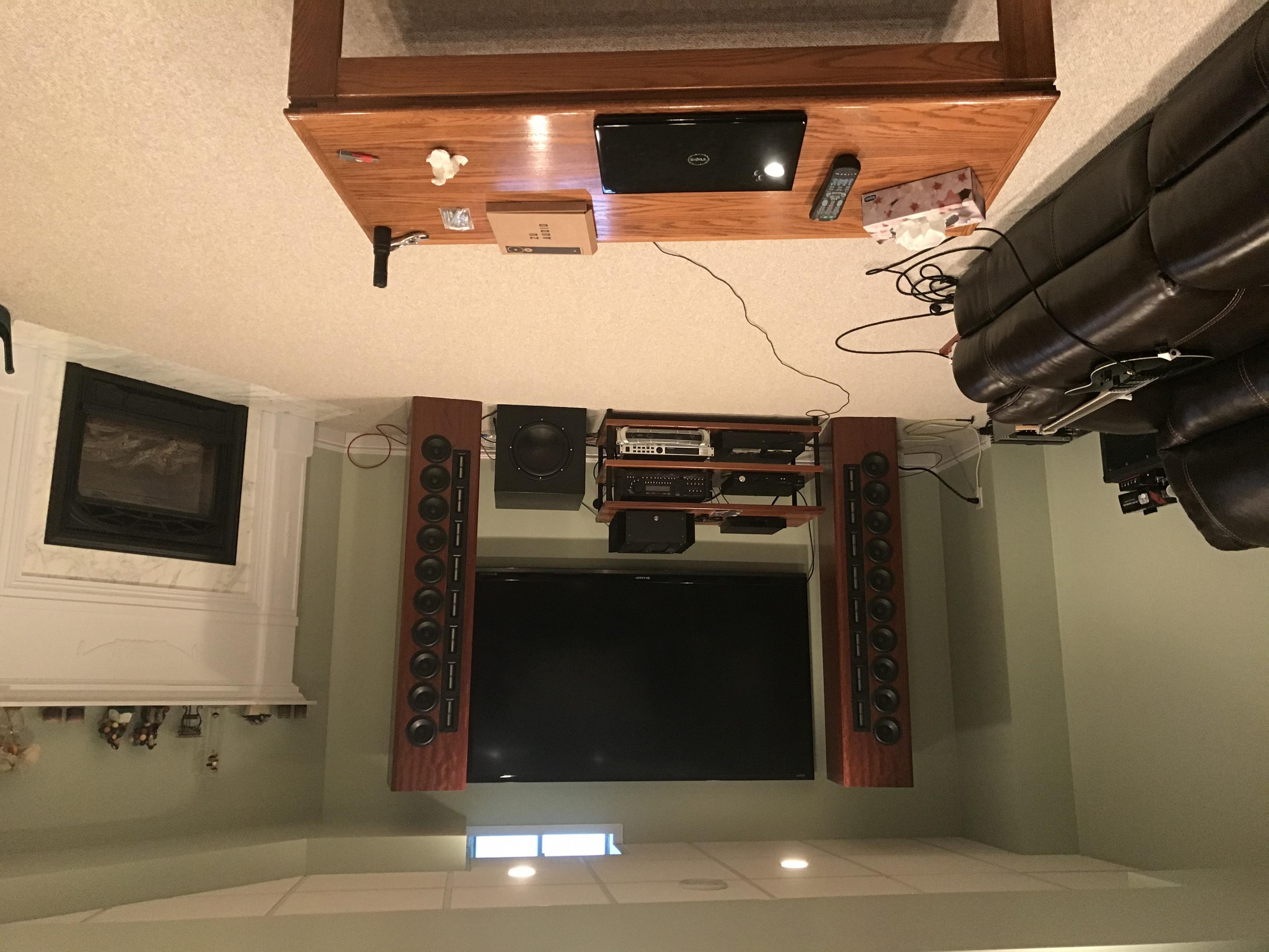
Regards,
Dan
Another interesting note I found in another tutorial is that 'zero' on the impulse graph should be in the middle of the largest peak.
If the largest peak is not on top at the time zero, go to the options menu shown above, and go under “time zero” and select “largest peak” and click “autodetect.” This should center the impulse on the time zero. If all the impulses you measure are upside down, you may need to check the “invert” box; if only some measurements are upside down, leave them be. It's important to get your time-zero lined up or your phase results will be wonky. You should check on this for every measurement (the “auto” usually gets it right, but it's worth confirming).
Taken from here............Guide to Speaker/Room Correction Using Freeware and JRiver
Regards,
Dan
Those instructions are for Holm Impulse so the Options Menu is not the same in REW. REW will normally set the peak at t=0 or it can be moved manually with offset. Aligning the peak to t=0 is a good idea.
If you had to pick a peak from the graphs you posted then the third one has the highest amplitude and I would go with that, but I think it is worth trying to find what is going on in the measurement as there is a lot of up down movement early on in the impulse which looks like it comes from the speaker itself.
It is important to know where the phase inversions come from, amp or DAC connected in opposite polarity, speaker wired incorrectly or and out of phase wired crossover.
In most multiway speakers the tweeter will fire first so if the tweeter is wired positive the first peak should be positive.
Are you using an active crossover, seems there might be a Behringer DCX on top of the inuke? Is the crossover 4th order LR acoustic or electric, if electric did you flatten the drivers out of band before adding the crossover and did you use delay to match the acoustic centres of the woofer and tweeter?
If you had to pick a peak from the graphs you posted then the third one has the highest amplitude and I would go with that, but I think it is worth trying to find what is going on in the measurement as there is a lot of up down movement early on in the impulse which looks like it comes from the speaker itself.
It is important to know where the phase inversions come from, amp or DAC connected in opposite polarity, speaker wired incorrectly or and out of phase wired crossover.
In most multiway speakers the tweeter will fire first so if the tweeter is wired positive the first peak should be positive.
Are you using an active crossover, seems there might be a Behringer DCX on top of the inuke? Is the crossover 4th order LR acoustic or electric, if electric did you flatten the drivers out of band before adding the crossover and did you use delay to match the acoustic centres of the woofer and tweeter?
Those instructions are for Holm Impulse so the Options Menu is not the same in REW. REW will normally set the peak at t=0 or it can be moved manually with offset. Aligning the peak to t=0 is a good idea.
If you had to pick a peak from the graphs you posted then the third one has the highest amplitude and I would go with that, but I think it is worth trying to find what is going on in the measurement as there is a lot of up down movement early on in the impulse which looks like it comes from the speaker itself.
It is important to know where the phase inversions come from, amp or DAC connected in opposite polarity, speaker wired incorrectly or and out of phase wired crossover.
In most multiway speakers the tweeter will fire first so if the tweeter is wired positive the first peak should be positive.
Are you using an active crossover, seems there might be a Behringer DCX on top of the inuke? Is the crossover 4th order LR acoustic or electric, if electric did you flatten the drivers out of band before adding the crossover and did you use delay to match the acoustic centres of the woofer and tweeter?
It is important to know where the phase inversions come from, amp or DAC connected in opposite polarity, speaker wired incorrectly or and out of phase wired crossover.
Since my spare set of speakers sound 'normal' I would rule out the amp or DAC.
The crossover on top of the iNuke is for the sub.
Attached here is the PDF for my wiring diagram.
One very important point. I did not design these speakers. I built them under the supervision of an accomplished designer.
These speakers have passive crossovers. Both are 24dB electrical with the acoustic slopes designed to work with the driver response.
Regards,
Dan
Attachments
Last edited:
An overall phase inversion won't make your speakers sound any different unless you are one of the rare individuals who claims to be able to detect absolute polarity.
Try pulling a speaker out from the wall more towards the centre of the room and measure on axis to see if the result is the same that will help to make any reflections further out in time and easier to see.
I'm only trying to help you to work out why your measurements look off not to criticise the design of the speaker. Without any knowledge of how it was built it is hard to know what to expect.
I would not expect a horizontally set truncated array with passive crossover to have a great impulse response but what you measured doesn't look like that either.
Try pulling a speaker out from the wall more towards the centre of the room and measure on axis to see if the result is the same that will help to make any reflections further out in time and easier to see.
I'm only trying to help you to work out why your measurements look off not to criticise the design of the speaker. Without any knowledge of how it was built it is hard to know what to expect.
I would not expect a horizontally set truncated array with passive crossover to have a great impulse response but what you measured doesn't look like that either.
Last edited:
- Home
- Design & Build
- Software Tools
- rePhase, a loudspeaker phase linearization, EQ and FIR filtering tool
